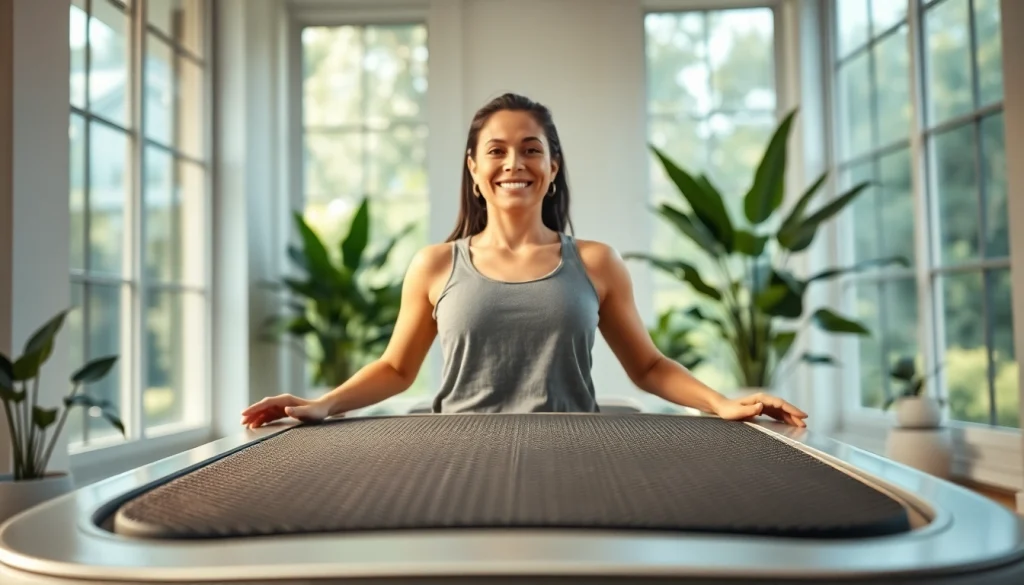What is Whole Body Vibration Therapy?
Overview of Whole Body Vibration Therapy
Whole body vibration therapy is a novel approach to fitness and rehabilitation that involves standing, sitting, or lying on a platform that emits vibrations. These mechanical oscillations transmit energy to the body, resulting in rapid muscle contractions and relaxation. The therapy has garnered attention for its potential benefits in enhancing muscle strength, flexibility, and overall well-being. Unlike traditional exercise regimens, whole body vibration therapy can engage muscle fibers without the need for extensive physical exertion. This aspect makes it particularly appealing for individuals with physical limitations or those looking for alternative ways to support their health.
The therapy attracts a diverse range of users, from professional athletes seeking an edge in their training to individuals recovering from injuries or managing chronic conditions. Its applications extend beyond fitness, with research suggesting benefits for improved circulation, pain relief, and even cognitive function. For more details on its benefits and applications, you can explore whole body vibration therapy.
How it Works: Mechanisms Behind the Therapy
The science behind whole body vibration therapy revolves around the concept of mechanical stimulation. When users position themselves on a vibrating platform, the generated vibrations resonate throughout the body. This mechanical stimulus activates muscle fibers, causing them to contract involuntarily. Depending on the frequency and amplitude of the vibrations, different physiological outcomes can occur.
Mild vibrations can improve blood circulation, enhancing nutrient delivery and waste removal within muscles. Higher frequencies may promote muscle strength and endurance by engaging more fast-twitch muscle fibers, typically used in explosive movements. Additionally, there is evidence that whole body vibration can stimulate proprioceptors in the muscles and tendons, contributing to better balance and coordination.
Applications and Uses in Health and Fitness
Whole body vibration therapy has a broad array of applications across various domains of health and fitness. In physical rehabilitation, it serves as a tool for post-operative recovery or injury rehabilitation, allowing patients to regain strength and mobility without overexerting themselves. Many practitioners utilize it to enhance recovery times and relieve muscle fatigue by stimulating blood flow to stressed areas.
In the realm of fitness, whole body vibration therapy is often incorporated into training programs to enhance results. It can be used as an adjunct to traditional strength training, where short sessions on a vibration platform might amplify the workout’s effectiveness. Furthermore, individuals seeking to improve overall body composition benefit from its ability to burn calories and enhance metabolic functions.
Finally, some studies have suggested cognitive benefits associated with whole body vibration therapy, including improvements in attention span and memory. This aspect could make it a valuable addition to therapeutic interventions targeting elders or individuals with cognitive impairments.
Benefits of Whole Body Vibration Therapy
Physical Health Improvements
One of the main advantages of whole body vibration therapy is its capability to yield physical health improvements without the high-impact stress that traditional workouts may impose. Both professional athletes and fitness novices have reported benefits, including:
- Enhanced Muscle Strength: Research demonstrates that both high-intensity and low-intensity whole body vibration can significantly increase strength in different muscle groups.
- Improved Flexibility: Regular exposure to vibrations can aid in enhancing range of motion and flexibility through muscle relaxation.
- Better Balance and Coordination: Whole body vibrations stimulate proprioception, leading to improvements in balance and reduced risk of falls, particularly among elderly individuals.
- Pain Relief: Many users have reported reduced discomfort in conditions such as arthritis and lower back pain, likely due to increased circulation and muscle relaxation.
Psychological and Emotional Benefits
The benefits of whole body vibration therapy are not limited to the physical realm; there are evident psychological and emotional advantages as well. The passive nature of the therapy can serve as a stress-reliever, allowing individuals to unwind and engage in a form of self-care. Users often report improved mood, reduced feelings of depression and anxiety, and enhanced clarity of thought after sessions.
Furthermore, since vibrations can influence neurotransmitter release (such as endorphins), patients may experience a natural mood boost. Regular therapy may foster a sense of well-being and improve quality of life, especially for those managing chronic conditions.
Enhancing Strength and Flexibility
Strength and flexibility are crucial components of physical fitness. Traditional workout methods require significant time and effort to yield results; however, whole body vibration therapy expedites this process by catalyzing muscle contractions naturally. In terms of strength, research suggests that consistent vibration therapy can improve muscle power by activating fast-twitch muscle fibers, essential for high-intensity athletic performances.
On the flexibility front, the technique promotes muscle relaxation post-exercise, potentially leading to greater flexibility gains. By engaging in a complete program that combines vibration therapy with stretching and mobility exercises, individuals may achieve a more balanced, functional physique.
Techniques and Best Practices for Effective Use
Proper Body Positioning on the Vibration Platform
To harness the full benefits of whole body vibration therapy, correct body positioning is crucial. Users should maintain a neutral spine and engage their core throughout the session. Here are some best practices:
- Foot Placement: Position your feet shoulder-width apart on the platform for stability. Users may experiment with wider stances for enhanced balance or narrow stances to challenge core strength.
- Maintain Alignment: Keep your body aligned, avoiding excessive leaning or slouching. Proper alignment ensures that vibrations effectively travel through the muscle groups targeted.
- Engage Muscles: Lightly engage core and leg muscles during the session; this will compound the effectiveness of the vibrations.
Setting the Right Frequency and Duration
The therapeutic effects of whole body vibration can vary significantly based on frequency and session duration. Typical settings range from 15 Hz to 60 Hz, with varying results:
- Low Frequency (15-30 Hz): Best for rehabilitation, balance training, and flexibility improvements.
- Moderate Frequency (30-40 Hz): Ideal for muscle strengthening and endurance enhancement.
- High Frequency (50-60 Hz): Typically used for advanced training and athletic conditioning.
In terms of duration, most users benefit from sessions lasting about 10-30 minutes, depending on their fitness level and goals. It is advisable to start with shorter sessions and gradually increase as one becomes accustomed to the vibrations.
Common Mistakes to Avoid During Sessions
To maximize efficiency and safety during whole body vibration therapy, it’s crucial to avoid common pitfalls:
- Inconsistent Use: For optimal results, establish a regular routine instead of sporadic sessions.
- Overexertion: Beginners should avoid jumping into high-frequency settings immediately. Gradually work up to more intense vibrations.
- Neglecting Hydration: Ensuring proper hydration is essential, as dehydrated muscles may not respond as effectively to vibrations.
Research and Evidence Supporting Whole Body Vibration Therapy
Recent Studies on its Efficacy
Numerous studies have affirmed the efficacy of whole body vibration therapy across various health and fitness applications. Recent systematic reviews have indicated positive outcomes in neuromuscular performance, muscle strength, and pain relief in both healthy individuals and patients with chronic conditions.
For instance, studies have shown that whole body vibration significantly improves muscle strength and mass in elderly populations and enhances functional capacity in individuals recovering from joint injuries. Researchers have also noted positive effects in terms of circulation and metabolic rate, hinting that vibration therapy might aid weight management efforts.
Comparison with Traditional Exercise Techniques
When evaluating whole body vibration therapy against traditional exercise methods, several key differences emerge:
- Time Efficiency: Whole body vibration can yield substantial fitness benefits in significantly less time, making it appealing for busy individuals.
- Accessibility: Vibration therapy is suitable for people with varying physical limitations, allowing them to engage in effective exercise without high exertion.
- Lower Impact: Unlike traditional workouts, whole body vibration minimizes wear and tear on joints, reducing the likelihood of injury.
While whole body vibration therapy is not meant to replace all forms of traditional exercise, it complements and enhances fitness regimens for a diverse range of users.
Future Research Directions in Whole Body Vibration Therapy
The future of whole body vibration therapy holds promising avenues for research and exploration. Upcoming studies aim to delve deeper into specific applications for various groups, especially those with specific health conditions like osteoporosis, cardiovascular diseases, and neurological disorders. Moreover, understanding the physiological mechanisms at play can pave the way for more personalized approaches to therapy.
Advancements in technology may also lead to the development of more sophisticated vibration platforms, incorporating biofeedback systems that tailor sessions based on individual responses, enhancing therapeutic outcomes.
Client Experiences and Testimonials
Success Stories from Users
Numerous users have shared their positive experiences after incorporating whole body vibration therapy into their routines. Many report significant improvements in strength, balance, and pain reduction. For instance, an individual recovering from knee surgery mentioned how regular sessions helped speed up their recovery process and restore mobility more quickly than anticipated.
Others have highlighted the therapy’s benefit in their weight management journey, with consistent sessions complemented by a balanced diet leading to observable body composition changes within a few months. These testimonials affirm the efficacy and enjoyable nature of whole body vibration therapy.
Realistic Expectations of Therapy Outcomes
While many individuals enjoy positive results, it is essential to maintain realistic expectations regarding therapy outcomes. Results can vary greatly among individuals, influenced by factors such as existing physical condition, frequency of use, and individual adherence to best practices.
Most users notice improvements in strength and mobility within a few weeks, while factors like weight loss and muscle growth may take longer depending on lifestyle. It is vital for users to approach whole body vibration therapy as a complementary tool within a broader health and fitness strategy rather than a standalone solution.
How to Get Started with Whole Body Vibration Therapy
Getting started with whole body vibration therapy is straightforward and can be seamlessly integrated into various fitness regimens. Here are some steps to initiate this journey:
- Consult a Professional: Before beginning any new therapy, consult with a healthcare professional or a trained therapist to determine suitability based on personal health conditions.
- Select the Right Equipment: Choose a high-quality vibration platform that suits your needs and budget. Familiarize yourself with its functionalities and settings.
- Establish a Routine: Begin with shorter sessions (around 10 minutes) at lower frequencies, gradually adding more time and intensity as your body adapts.
- Monitor Results: Keep track of improvements in strength, flexibility, and overall well-being, adjusting your program accordingly to meet your goals.
By adopting whole body vibration therapy into your wellness toolkit, you’ll be taking a proactive step toward supporting your physical health and enhancing your quality of life.


